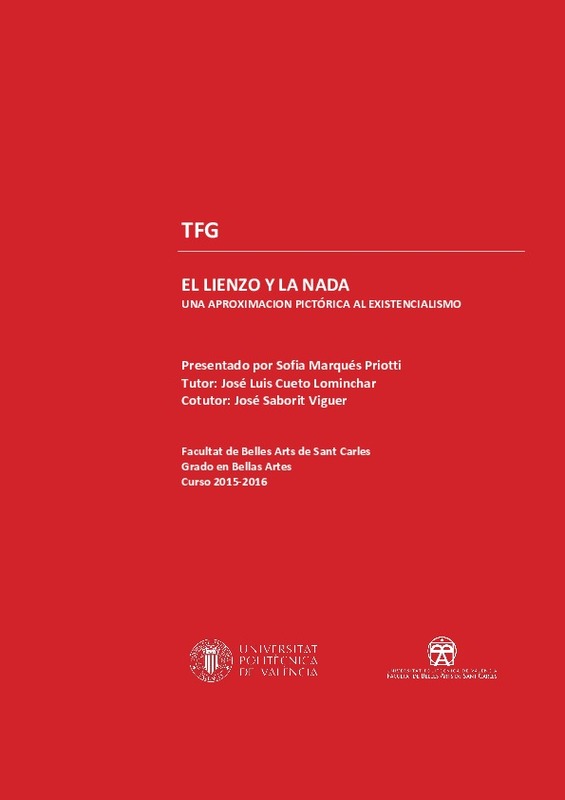|
Resumen:
|
[EN] This
theoretical and practical
project
aims to move through a pictorial
production
o
f
the main philosophical reflections led by JP Sartre, A. Camus and
F. Pessoa
, who
revolve around the philosophical ...[+]
[EN] This
theoretical and practical
project
aims to move through a pictorial
production
o
f
the main philosophical reflections led by JP Sartre, A. Camus and
F. Pessoa
, who
revolve around the philosophical tr
end of existentialism, which
emerged in the nineteenth centu
ry and extends
to the present.
A
tendency
particularly accentuated during the interw
ar period, where
faith in humanity
is
lost and now humans
seem to
have
become their own worst enem
ies.
Based on
these theoretical references, production is composed of several
figurative
paintings
that attempt to avoid excessive description and
superfluous det
ail. It has created a profile according to
the particularities of
each individual, paying attention to the s
tudy of differe
nt essential
concepts
such as existence, angst, freedom, death, responsibility, commitment,
absurdity and God.
On the other hand,
regarding
formal aspects, it is important to
emphasize the
decisive influence of
the intimate
photography
and
figure of Nan Goldin,
who
plays
a fundamental role
in developing
the aesthetic of the “exist
en
tialist”
individual.
She takes pictures of family and friends as a visual diary, showing
honest pictures far beyond
privacy and conventional limits
, portraying
a
subculture that society refused to accept.
Thereby
, looking directly into the philosoph
y and photography, painting gains
momentum and becomes
a mirror of
reflection
[-]
[ES] El presente
trabajo teórico
-
práctico persigue trasladar
,
a través de una
producción pictórica, las principales reflexiones filosóficas
encabezadas por J.P
Sartre, A. Camus y F. Pessoa ...[+]
[ES] El presente
trabajo teórico
-
práctico persigue trasladar
,
a través de una
producción pictórica, las principales reflexiones filosóficas
encabezadas por J.P
Sartre, A. Camus y F. Pessoa que giran
en torno a la corriente
filosófica del
Existe
ncialismo, surgid
a
en el
siglo X
I
X
y extendida
hasta
la actualidad.
Una
tendencia especialmente a
centuada durante el período
de entreguerras,
donde l
a humanidad
pierde
la fe en sí misma
y el hombre
devastado,
se
convierte
en su peor enemigo.
Partiendo d
e
esta base teórica
, la
producción
se compone
por una serie
obras
de carácter
figurativo
que intentan evitar la excesiva descripción y el detalle
superfluo.
S
e ha creado un perfil,
sujeto a las particularidades de cada
individuo, prestando atención
al est
udio de
diferentes conceptos
fundam
entales como la existencia, la
angustia, la libertad, la muerte, la
responsabilidad, el compromiso, el absurdo
y
Dios.
Por otro lado,
a nivel formal,
subrayar la influencia de
terminante de
la
fotografía
intimista
y la fig
ura de
Nan Goldin
,
como pieza
s
fundamental
es
en el
marco práctico,
para la elaboración y reflexión
acerca del
individuo
“existencialista”.
Diarios de vida que guardan una fotografía honesta hasta la
misma repugnancia, derrumbando los límites de la privacid
ad
y lo
convencional,
re
tratando
una subcultura que
la sociedad
se negaba a aceptar
.
M
irando directamente
a la filosofía
y
a
la fotografía
, la pintura coge impulso,
se vuelve
espejo y
reflexión
[-]
|







